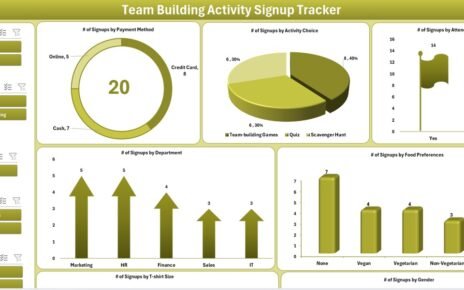VLOOKUP is a popular function in Microsoft Excel. It helps users to find and retrieve specific data from a large table or range of data. However, there is a limitation of traditional VLOOKUP that it only works with data which is explicitly matched to a lookup value. But what if you need to find and match data based on the background color of a cell? This is where “VLOOKUP by cell background” color comes in.
You will need to create a User Defined Function (UDF) in VBA to use VLOOKUP by cell background color. This function will allow you to access the value of a cell based on its background color.
Below is the VBA code to create the VLOOKUP by cell background color function-
Function myvlookup(r1 As Range, r2 As Range, n As Integer, a As Boolean) As Variant Application.Volatile Dim cel As Range Dim i As Integer i = 0 For Each cel In r2 If cel.Interior.Color = r1.Interior.Color Then myvlookup = cel.Offset(0, n - 1).Value i = i + 1 If a = False Then Exit For End If End If Next If i = 0 Then myvlookup = "#N/A" End Function
Follow the below steps to create this User defined function in your worksheet-
- Copy the above code and open the Visual Basic Editor by pressing Alt+F11.
- Insert a new module by pressing Alt+I+M.
- Paste the code into the module.
- Save the workbook as a Macro enabled workbook.
- Once you’ve completed these steps, you can use the myvlookup function in your worksheet to retrieve data based on cell background color.
How to use this function in Excel worksheet?
Let’s say you have a table of sales data on range “A1:B15” and you want to retrieve sales data from column B based on the background color of cells in range “D2:D4”. Here’s how you can do it:
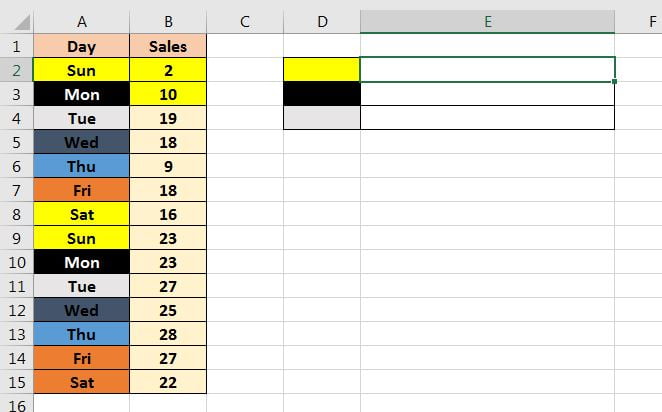
Enter the formula “=myvlookup(D2,$A$1:$B$15,2,0)” in cell E2. This formula tells Excel to look up the value in cell D2 and retrieve the corresponding value from column B.
Copy the formula down to cells E3 and E4 to retrieve the sales data for each cell in range D2:D4.
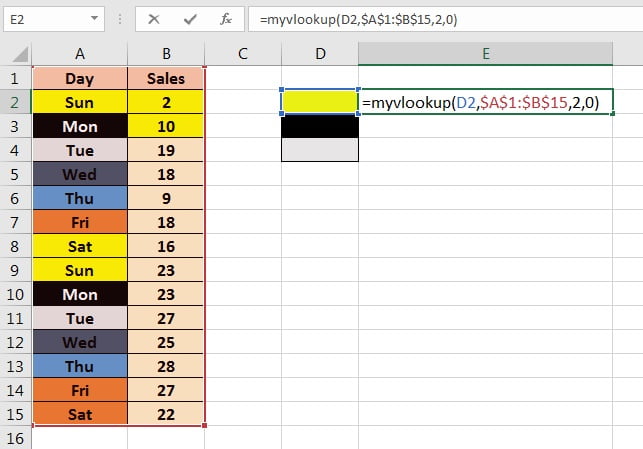
Note that the last argument in the formula is set to 0, which means that the function will return the first value it finds that matches the lookup value based on background color.
As you are seeing in below image value available on column E are the first found values.
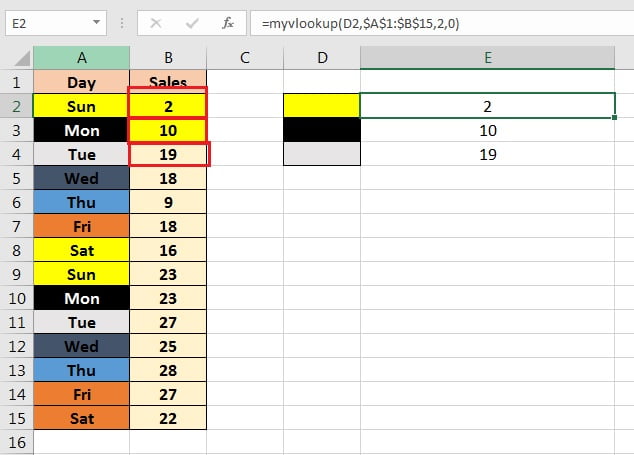
To get the value which is available in the last we need to use 1 in place of 0 in myvlookup formula “(=myvlookup(D2,$A$1:$B$15,2,1)”
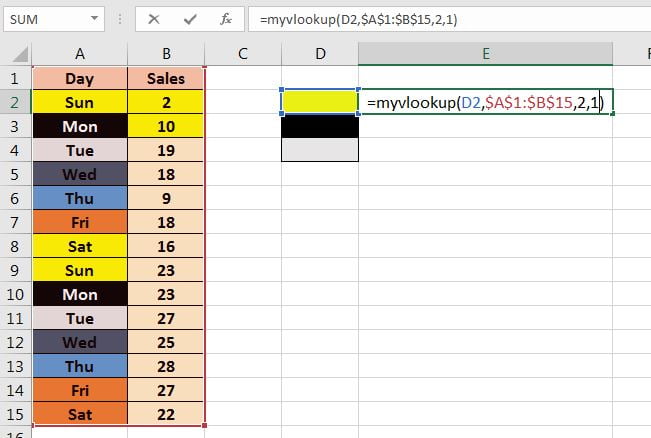
Now we will get the last value for that cell background color.
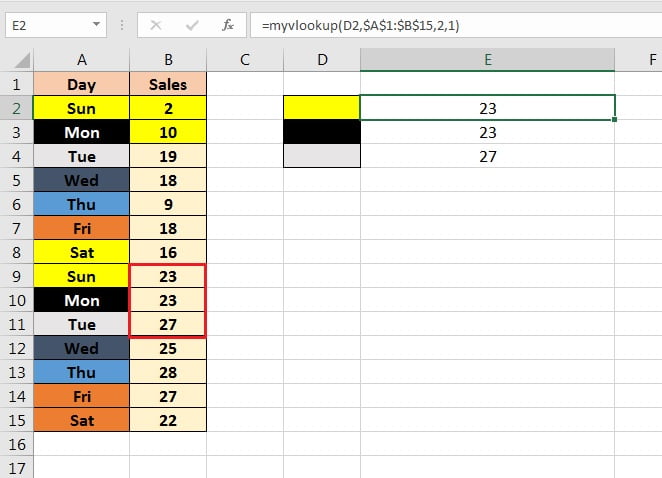
Please make it point that because this formula is based on the background color of cells, it will not automatically refresh when you change the background color of a cell. To get the updated value from the formula, you need to go to the formula tab and click on “Calculate Now” or press F9 shortcut Key to recalculate the formula.
In conclusion, using VLOOKUP by cell background color can be a useful tool for data analysis in Excel. You can retrieve data based on cell background color instead of explicitly matched data by creating a User Defined Function in VBA. While it may require a bit of setup, it can be a valuable addition to your Excel toolbox.
Frequently Asked Questions:
Q. What is the purpose of VLOOKUP by cell background color?
A. VLOOKUP by cell background color is a useful tool for data analysis in Excel, allowing users to find and retrieve data based on the background color of a cell rather than explicitly matched data. It requires creating a User Defined Function (UDF) in VBA to access cell values based on their background color.
Q. How can I create a User Defined Function (UDF) for VLOOKUP by cell background color?
A. To create a UDF for VLOOKUP by cell background color, follow these steps:
a. Copy the provided VBA code.
b. Open the Visual Basic Editor by pressing Alt+F11.
c. Insert a new module by pressing Alt+I+M.
d. Paste the code into the module.
e. Save the workbook as a Macro-enabled workbook.
Q. How do I use the myvlookup function in my Excel worksheet?
A. To use the myvlookup function in your Excel worksheet, enter the formula “=myvlookup(D2,$A$1:$B$15,2,0)” in cell E2. Adjust the formula to match the appropriate cell ranges and columns for your specific dataset. Copy the formula down to the other cells as needed.
Q. How do I update the values retrieved by the myvlookup function when the background color changes?
A. Since the myvlookup function is based on cell background color, it does not automatically refresh when you change the background color. To update the values, go to the Formula tab and click on “Calculate Now” or press F9 to recalculate the formula.
Q. Can I use the myvlookup function to retrieve the last value matching the cell background color?
A. Yes, you can use the myvlookup function to retrieve the last value matching the cell background color by changing the last argument in the formula from 0 to 1, like this: “=myvlookup(D2,$A$1:$B$15,2,1)”.
Q. Is VLOOKUP by cell background color a valuable addition to my Excel toolbox?
A. Yes, VLOOKUP by cell background color can be a valuable addition to your Excel toolbox. It allows you to retrieve data based on cell background color, which can be helpful in various data analysis tasks. While it requires some initial setup, the benefits can make it worth the effort.
Watch the step-by-step video tutorial:
Click here to download the practice file
Visit our YouTube channel to learn step-by-step video tutorials


